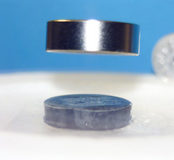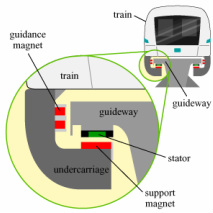Physics of Maglev Train
Magnets

Figure 1
The Maglev Train is still under development and many scientists are working on the project. The basic idea is to use magnets to power the train; however, it's not yet possible to make the magnetic repulsion constant. Figure 1 show the sides of the magnets are repelling each other and one is repelling another into the air, which makes them levitate. But that's just under ideal conditions. In reality, the one on the top of the magnet will fall down to the side. So many different ideas have come out to figure out this problem.
EMS System

Figure 2
Figure 2 shows a system that was introduced by a German scientist. Its system is called Transrapid. This design uses EMS technology. EMS is also known as Electromagnetic suspension altering. EMS systems use the attractive property of magnets as shown in figure 2. Since the same pole of magnets attracted to each other, the stator and support magnets are attracted to each other in figure 2. It causes the train to not land on the track. It adjusts the power of the magnetic field produced by electromagnets that levitate an object into the air. As shown in figure 2, there is a guidance magnet on the side of the track that generates the magnetic force that prevents the train from moving side to side. It also designed as the C-form to keep the train in the bounce. As you can see in the picture, the train can't touch any side of the track levitating in the air because of the magnetic force pushing the train to the middle.
Electromagnetic Induction

Figure 3
The Maglev can also run in a different way. In Japan, the scientists used the technology of Electrodynamics Suspensions. To understand the idea of this technology, some understanding of electromagnetic induction is required. Electromagnetic induction was discovered in 1831 by Michael Faraday. The basic idea is that changing a magnetic field will cause an induction in current. As shown in figure 3, when the magnet moves through the coils, which is a conductor, the magnetic field inside the coil gets changed and inducts the current. This idea is used in many different fields and has a wide variety of applications. Electric generators, electric motors, transformers and pickups for electric instruments are a few examples. There are few rules we should know in order to understand electromagnetic induction. Faraday's law of induction states that a potential difference is induced in a loop when the number of magnetic field lines passing through the loop changes with time. Lenz's law states that an induced current will have a direction such that the magnetic field- due to the induced current- opposes the changes in the magnetic flux that induces the current.
EDS System

Figure 4
EDS stands for Electrodynamics suspension. As the maglev train travels at high speeds through the coils, superconducting magnets on the side of the train induce the current from the coils. A magnetic field is generated as shown in the picture on top of figure 4. The EDS system works as an opposing pole for the magnetic field on the front of the train, this way the train can move without any other force while the train is levitating on the track. The magnetic field on the back of the train will change to the same pole of the magnetic field on the train which pushes the train. Now the train has no friction levitating on the track with a magnetic system that makes it goes smooth and fast. The picture on the bottom of figure 4 shows this demonstration.